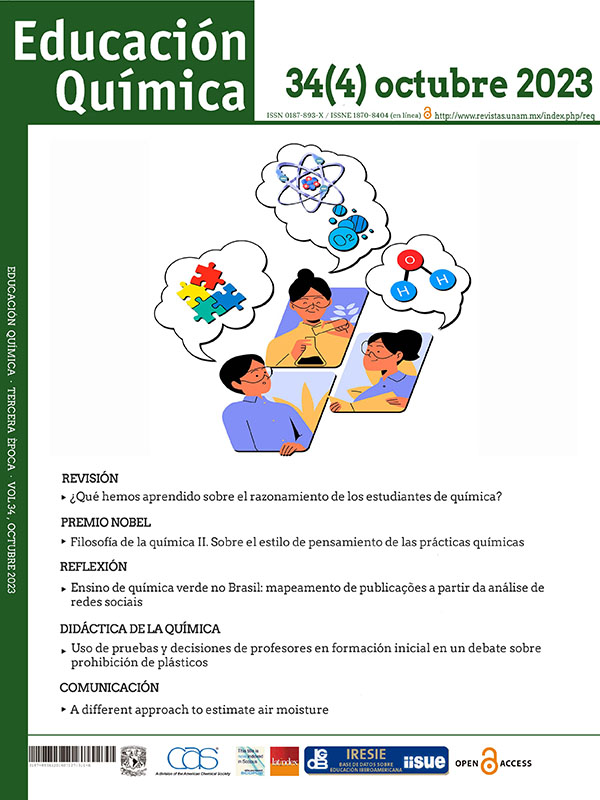Percepción sobre las actividades de aprendizaje desarrolladas en un curso de química general en pandemia
Contenido principal del artículo
Resumen
La pandemia de covid-19 generó diversas dificultades en la docencia universitaria e innovaciones en la didáctica de la química. Esta investigación presenta el diseño de material didáctico en base a la percepción del estudiantado en la asignatura de Química General para estudiantes de Ingeniería durante el segundo semestre de 2021. Se empleó un diseño de investigación acción participativa, a través de encuestas de percepción y grupos focales para indagar los antecedentes sociodemográficos, la satisfacción con la asignatura, la participación en clases y percepción sobre las guías de aprendizaje Armagedón. Entre los resultados principales destaca una elevada satisfacción con la asignatura y las guías de aprendizaje diseñadas, una participación baja y aspectos a mejorar en el formato de las guías de aprendizaje. Estos resultados concuerdan con la percepción positiva de otras innovaciones empleadas en asignaturas de química y permitieron la mejora continua de las guías de aprendizaje.
Detalles del artículo
Citas en Dimensions Service
Citas
Aguiar, B., Velázquez, R., y Aguiar, J. (2019). Innovación docente y empleo de las TIC en la Educación Superior. Revista Espacios, 40(2), 8. http://repositoriobibliotecas.uv.cl/handle/uvscl/2134
Cabrera Coronel, A. M., Centurión de Gómez, N. S., y Mora Rojas, C. O. (2022). Virtualización de clases presenciales en la universidad. Educación Química, 33(3), 107–114. https://doi.org/10.22201/FQ.18708404E.2022.3.80254
Cáceres, P. (2003). Análisis cualitativo de contenido: una alternativa metodológica alcanzable. Psicoperspectivas. Individuo y Sociedad, 2(1), 53–82. https://doi.org/10.5027/PSICOPERSPECTIVAS-VOL2-ISSUE1-FULLTEXT-3
Catalán, J. (2021). Análisis de Investigación Educacional Cualitativa. Aprendiendo a usar y generar conocimiento. (1a ed.). Editorial Universidad de La Serena. La Serena, Chile.
Cedeño, F., y Jiménez, C. (2022). Experiencias docentes durante la pandemia: Curso experimental. Educación Química, 33(2), 82–93. https://doi.org/10.22201/FQ.18708404E.2022.2.80235
de Freitas, A. G. O., Irala, V. B., y Bordin, D. M. (2021). Los retos de la enseñanza de Química en la pandemia de COVID-19: la metodología flipped classroom adaptada para el modo virtual en Brasil. Educación Química, 32(4), 6–22. https://doi.org/10.22201/FQ.18708404E.2021.5.78169
Delgado, W. A., Karim, J., Gonzales, B., Camacho, L. M., Delgado, A., y Camacho, M. (2021). ICT AND ITS SUPPORT IN UNIVERSITY EDUCATION IN TIME OF PANDE-MIC: A FACTO-THEORETICAL FOUNDATION. En Revista Conrado (Vol. 17, Número 78). https://conrado.ucf.edu.cu/index.php/conrado/article/view/1665
Hodges, C., Moore, S., Lockee, B., Trust, T., y Bond, A. (2020). The Difference Between Emergency Remote Teaching and Online Learning. Educase Review, 1–15. https://er.educause.edu/articles/2020/3/the-difference-between-emergency-remote-teaching-and-online-learning
Mseleku, Z. (2020). A Literature Review of E-Learning and E-Teaching in the Era of COVID-19 Pandemic. International Journal of Innovative Science and Research Technology, 5(10), 588–597. https://ijisrt.com/a-literature-review-of-elearning-and-eteaching-in-the-era-of-covid19-pandemic
Padilla-Zúñiga, J., Soto-Estrada, A. M., Serratos, I. N., y Castañeda-Villa, N. (2020). La enseñanza remota ante el COVID-19 : Experiencias de la docencia en cuatro asignaturas de la UAM-I. Educación Química, 31(5), 144–151. https://doi.org/10.22201/FQ.18708404E.2021.6.77106
Pérez, A. (2021). La enseñanza de la física y la química en tiempos de pandemia. Anales de Química de la RSEQ, 117(2), 150–150. https://analesdequimica.es/index.php/AnalesQuimica/article/view/1656
Reyes-Cárdenas, F., Ruiz-Herrera, B., Llano-Lomas, M., Lechuga-Uribe, P., y Mena-Zepeda, M. (2021). Chemistry students´ perception on the change in educational modality due to the COV-ID-19 pandemic. En Educacion Quimica (Vol. 32, Número 5, pp. 127–141). Facultad de Química, UNAM. https://doi.org/10.22201/fq.18708404e.2021.5.78240
Rodríguez, D. F. B., Figueredo, O. R. B., y Mendivelso, M. B. (2020). Percepciones de los profesores y estudiantes sobre la enseñanza remota durante la pandemia COVID-19: Caso del Colegio Misael Pastrana Borrero. Educación Química, 31(5), 129–135. https://doi.org/10.22201/FQ.18708404E.2020.5.77086
Solis, M., Torres, M. C., Huaringa, J., y Carbajal, M. (2021). Educación superior remota en tiempos de Pandemia. RISTI, 1–10. https://pesquisa.bvsalud.org/global-literature-on-novel-coronavirus-2019-ncov/resource/en/covidwho-1516034
Tirado, S., Vázquez, A. M., y Toledano, R. M. (2021). Virtual Teaching or e-Learning as a Solution to the Teaching of Physics and Chemistry of Future Teachers in times of COVID-19. Revista Espanola de Educacion Comparada, 38(38), 190–210. https://doi.org/10.5944/REEC.38.2021.28853
Wahid, R., Pribadi, F., y Wakas, B. E. (2020). Digital Activism: COVID-19 Effects in Campus Learning. Budapest International Research and Critics in Linguistics and Education (BirLE) Journal, 3(3), 1336–1342. https://doi.org/10.33258/BIRLE.V3I3.1174

Educación Química por Universidad Nacional Autónoma de México se distribuye bajo una Licencia Creative Commons Atribución-NoComercial-SinDerivar 4.0 Internacional.
Basada en una obra en http://www.revistas.unam.mx/index.php/req.




